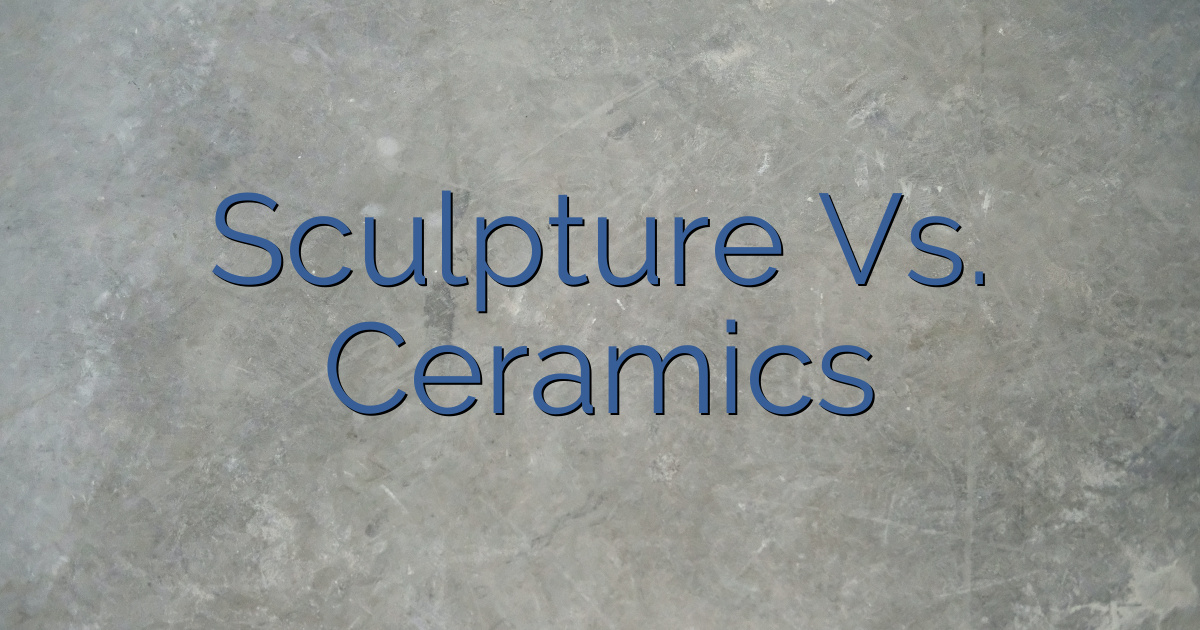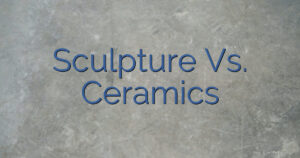
Are you torn between the captivating world of sculpture and the intricate artistry of ceramics? Delve into the realm of creativity as we explore the differences and similarities between these two majors.
Discover the technical skills developed, the career opportunities that await, and the potential salary in both sculpture and ceramics programs.
Uncover the nuances of each artistic technique and gain insight into the factors to consider when choosing between these mesmerizing disciplines.
Let the journey begin.
Table of Contents
Key Takeaways – Sculpture Vs. Ceramics
- Sculpture and ceramics majors offer unique opportunities for artistic exploration and can lead to careers as professional artists or in industries that require creative skills.
- Both majors have growing demand for art educators and offer specializations to cater to specific interests and goals.
- The curriculum for both majors emphasizes hands-on learning, working with various materials and techniques, and is guided by experienced faculty members.
- Sculpture focuses on developing technical skills, spatial understanding, and conceptual thinking, while ceramics focuses on clay, precision, and control in techniques like wheel throwing and hand-building. Both fields offer diverse job roles and opportunities for artists to make a meaningful impact in the art world.
Overview of Sculpture and Ceramics Majors
If you’re interested in pursuing a major in sculpture or ceramics, you’ll find that both offer unique opportunities to explore your artistic talents.
When it comes to job prospects, graduates in sculpture and ceramics have a range of options available to them. Many pursue careers as professional artists or find work in industries that require their creative skills, such as advertising, design, and architecture. Additionally, there is a growing demand for art educators, allowing graduates to share their knowledge and passion with others.
Within sculpture and ceramics programs, there are various specializations to choose from. In sculpture, you can focus on traditional techniques like carving and modeling, or explore contemporary methods such as installation and mixed media. Ceramics programs often offer specializations in areas like pottery, porcelain, or sculpture using clay. These specializations allow students to develop a unique artistic voice and hone their skills in a specific area of interest.
Overall, both sculpture and ceramics offer exciting prospects for artistic expression and future career paths.
Overview of the curriculum and courses offered
Take a look at the curriculum and courses available to you, as they offer a comprehensive overview of the program. Here’s what you can expect:
- Studio Requirements: The program emphasizes hands-on learning, providing you with ample studio time to develop your skills in both sculpture and ceramics. You will have the opportunity to work with a variety of materials and techniques, including clay, stone, metal, and more.
- Faculty Expertise: Our experienced faculty members are renowned artists and educators in the field of sculpture and ceramics. They bring a wealth of knowledge and expertise to the classroom, guiding you through the creative process and helping you refine your artistic vision.
- Core Courses: You will take foundational courses in both sculpture and ceramics, covering topics such as design principles, 3D modeling, mold-making, and firing techniques. These courses will lay the groundwork for your artistic development.
- Electives: In addition to the core courses, you will have the opportunity to choose from a range of elective courses that cater to your specific interests and goals. These courses may include advanced sculpture techniques, ceramic sculpture, installation art, or even interdisciplinary collaborations.
Overview of coursework and assessments in sculpture and ceramics programs
Explore the coursework and assessments available to you in the sculpture and ceramics programs, as they play a crucial role in your artistic development.
In sculpture, you will engage in a range of techniques and materials, such as wood carving, metalworking, and stone sculpting. The coursework focuses on developing your technical skills, spatial understanding, and conceptual thinking. Assessments often include portfolio reviews and critiques, where you receive feedback from faculty and peers to refine your artistic practice.
In ceramics, you will learn various hand-building techniques, wheel throwing, glazing, and firing processes. The curriculum emphasizes both functional and sculptural ceramics, requiring you to experiment with forms, textures, and surface treatments. Assessments typically involve kiln-fired projects and exhibitions.
When it comes to career opportunities, sculpture can lead to roles such as public art installations, gallery exhibitions, and teaching. In contrast, ceramics offers avenues like pottery production, ceramic design, and studio ownership. Both disciplines provide exciting possibilities for artistic expression, but it’s essential to consider your interests, strengths, and long-term goals when choosing between them.
Comparison of Technical Skills Developed
Developing your technical skills in both sculpture and ceramics programs will equip you with the ability to manipulate various materials and create visually engaging artworks. When comparing the creative expression and evaluation of technical mastery in sculpture and ceramics, several key differences emerge:
- Materials: In sculpture, you have the opportunity to work with a wide range of materials, including wood, metal, and stone. This allows for more experimentation and exploration of different textures and forms. On the other hand, ceramics primarily focuses on clay, which requires a different set of skills for shaping and firing.
- Techniques: Sculpture often involves more complex techniques such as welding, carving, and casting. These techniques require a higher level of technical proficiency and mastery. In ceramics, techniques like wheel throwing and hand-building are emphasized, focusing on precision and control.
Comparison of Career Opportunities and Job Roles in Sculpture Vs. Ceramics
When comparing career opportunities and job roles in sculpture and ceramics, it’s important to consider the unique paths and possibilities each field offers.
Sculpture, as an art form, allows for a wide range of career options. Sculptors can work as independent artists, creating their own pieces for galleries, museums, and public spaces. They can also collaborate with architects, designers, and other professionals to create large-scale installations. In addition, sculpture offers opportunities in art education, where sculptors can teach and inspire others.
On the other hand, ceramics offers a different set of career paths. Ceramic artists can work in pottery studios, creating functional and decorative pieces for sale. They can also specialize in ceramic restoration and conservation, working in museums and cultural institutions.
Both fields offer exciting and diverse job roles, allowing artists to explore their creativity and make a meaningful impact in the art world.
Comparison of Salary Potential in Sculpture Vs. Ceramics Programs
To understand the salary potential in sculpture and ceramics programs, you should consider factors such as experience, location, and demand for the specific skillset in the art industry.
When it comes to salary potential in these fields, it is important to note that the art industry can be highly competitive and subjective. However, both sculpture and ceramics offer unique opportunities for artists to earn a living.
The salary potential in sculpture programs can vary greatly depending on factors such as the artist’s reputation, the size and complexity of the sculptures created, and the demand for their work.
Similarly, in ceramics programs, the salary potential can be influenced by factors such as the artist’s experience, the quality and uniqueness of their ceramic pieces, and the demand for their work in the market.
Ultimately, job prospects and salary potential in sculpture and ceramics programs are intricately tied to an artist’s skill, experience, and ability to market their work effectively.
Similarities between sculpture and ceramics programs’ curricula
In both sculpture and ceramics programs, you’ll find a focus on developing technical skills and exploring various artistic techniques. These programs offer similar teaching methods and studio practices that aim to foster creativity and mastery of the medium.
Some of the similarities you’ll find between sculpture and ceramics programs include:
- Emphasis on hands-on learning: Both programs provide ample opportunities for students to work with their hands and engage in tactile experiences.
- Exploration of materials: Students in both programs experiment with different materials, such as clay, plaster, metal, and wood, to create their artworks.
- Development of critical thinking skills: Both programs encourage students to think critically about their artistic choices and conceptualize their ideas.
- Collaboration and critique: Students in both programs engage in collaborative activities and receive feedback from their peers and instructors.
- Historical and theoretical studies: Both programs incorporate the study of art history and theory to provide a context for students’ artistic practice.
Overall, sculpture and ceramics programs share many similarities in their teaching methods and studio practices, allowing students to develop their technical skills and artistic vision.
Difference in artistic techniques between the two majors.
If you choose to focus on ceramics, you’ll discover a distinct emphasis on shaping and molding clay to create three-dimensional forms.
Artistic techniques in ceramics involve various processes, such as hand-building, wheel-throwing, and slip-casting.
Hand-building allows you to create sculptures by shaping clay with your hands and tools.
Wheel-throwing involves using a pottery wheel to shape clay into functional or decorative vessels.
Slip-casting is a technique where liquid clay is poured into a mold to create multiple identical pieces.
These techniques require a deep understanding of the properties of clay, such as its plasticity and firing temperatures.
Additionally, creative processes in ceramics often involve experimentation with glazes, surface finishes, and kiln firing techniques to achieve desired results.
Factors to consider when choosing between sculpture and ceramics majors based on interests
Consider your personal interests and passions when deciding between the sculpture and ceramics majors, as this will greatly impact your overall satisfaction and success in your chosen field.
When choosing between these two majors, there are several factors to consider based on your personal preferences.
Firstly, think about the type of materials you enjoy working with. If you have a preference for three-dimensional forms and enjoy working with a variety of materials such as wood, metal, or stone, then sculpture might be the right choice for you.
On the other hand, if you have a fascination with clay and enjoy the tactile experience of shaping and molding it into functional or decorative objects, then ceramics might be more suitable.
Additionally, consider the artistic techniques and processes that excite you the most. Sculpture involves techniques like carving, modeling, and assembling, while ceramics focuses on hand-building, wheel-throwing, and glazing.
Reflecting on your personal strengths and interests will help you make an informed decision and set the foundation for a successful and fulfilling career in either sculpture or ceramics.
Conclusion
In conclusion, while both sculpture and ceramics majors offer unique and valuable skills, you may be concerned about the limited job opportunities in these fields.
However, it is important to remember that pursuing a career in the arts is not solely about financial gain. It is about following your passion and creating meaningful work that resonates with others.
By honing your artistic skills and pushing the boundaries of creativity, you have the power to make a lasting impact in the world. Don’t let the fear of financial stability hold you back from pursuing your dreams in sculpture or ceramics.

